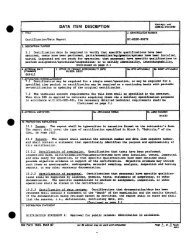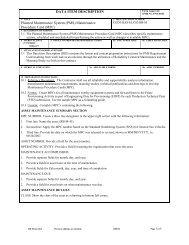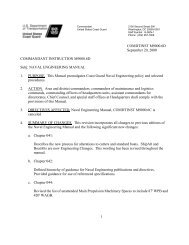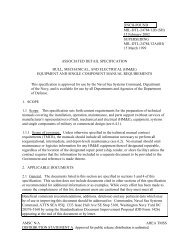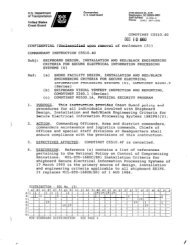- Page 1 and 2:
Commandant United States Coast Guar
- Page 3 and 4:
Table of Contents CHAPTER 1 General
- Page 5 and 6:
COMDTINST M2400.1F CHAPTER 1. GENER
- Page 7 and 8:
1.E.5. Abbreviations. Abbreviations
- Page 9 and 10: 1.J.4. Emissions Abbreviations. Nec
- Page 11 and 12: Symbol Type of Emission 0 No modula
- Page 13 and 14: Symbol A B C D E F G H J K L M N W
- Page 15 and 16: CHAPTER 2. SEARCH AND RESCUE A. Gen
- Page 17 and 18: 2.B.2. c. Transmission. With the ex
- Page 19 and 20: E. On-Scene Search and Rescue Frequ
- Page 21 and 22: F. Maritime SAR Operations by OG Ve
- Page 23 and 24: H. Disaster Communications Service.
- Page 25 and 26: I. VHF-FM Maritime Mobile Frequency
- Page 27 and 28: CHAPTER 3. AIDS TO NAVIGATION A. Ma
- Page 29 and 30: C. Loran-C. Loran is a pulsed preci
- Page 31 and 32: E. Radar. The radar bands for shipp
- Page 33 and 34: 3.G. Radar Beacons (Racon). Radar b
- Page 35 and 36: I. Omega. Omega is a very-low frequ
- Page 37 and 38: for the Federal Aviation Administra
- Page 39 and 40: C. National Frequency Management Pr
- Page 41 and 42: D. International Frequency Manageme
- Page 43 and 44: provide frequency separation criter
- Page 45 and 46: 4.F. Requests for Frequency Assignm
- Page 47 and 48: CHAPTER 5 RADIO INTERFERENCE AND RA
- Page 49 and 50: B. Radio Violation Reports. 1. Acti
- Page 53 and 54: ENCL. (5-1) TO COMDINST M2400.1F AG
- Page 55 and 56: Commanders are encouraged to make l
- Page 57 and 58: B. GMDSS System and Operational Det
- Page 59: 6.B.9. VHF. VHF will provide short
- Page 63 and 64: F. On Scene Communications. On scen
- Page 65 and 66: Enclosure (1) TO COMDTINST M2400.1F
- Page 67 and 68: A01.02 PACIFIC AREA HF SHIP/SHORE T
- Page 69 and 70: A01.04 PACIFIC AREA MF SHIP/SHORE (
- Page 71 and 72: A02 CARIBBEAN AND GULF OF MEXICO AR
- Page 73 and 74: A02.03 CARIBBEAN AND GULF OF MEXICO
- Page 75 and 76: 13027.5 (13025.5) 15656.5 (15654.5)
- Page 77 and 78: A03.03 NORTH ATLANTIC HF SSB RADIOT
- Page 79 and 80: A04.02 EASTERN PACIFIC HF RADIOTELE
- Page 81 and 82: A05 ALASKA AND BERING SEA AREA A05.
- Page 83 and 84: A05.03 ALASKA AND BERING SEA HF SSB
- Page 85 and 86: A06.02 WESTERN PACIFIC HF RADIOTELE
- Page 87 and 88: A07 LOCAL AREA A08 NAVY SHIP/SHORE
- Page 89 and 90: A11 CONTACT AND LONG-RANGE LIAISON
- Page 91 and 92: COMMON CHANNELS/kHz series 3 4184 6
- Page 93 and 94: A11.04 ATLANTIC/PACIFIC CALL HF WOR
- Page 95 and 96: A13 RADIOTELEPHONE SHIP/SHORE PUBLI
- Page 97 and 98: A14 GENERAL SHORE/SHIP INDEPENDENT
- Page 99 and 100: 10353 10353.5 10354.5 10356 10356.5
- Page 101 and 102: 20516.5 20517 20518 20519.5 20520 2
- Page 103 and 104: 12372 12370.5 12371 12374 12373.5 1
- Page 105 and 106: Enclosure (2) TO COMDTINST M2400.1F
- Page 107 and 108: B-3
- Page 109 and 110: B21 NEW ENGLAND AREA FACSIMILE MARI
- Page 111 and 112:
E01 PRIMARY AIR/SURFACE E01.01 PRIM
- Page 113 and 114:
E03.03 JOINT CUSTOMS SERVICE COAST
- Page 115 and 116:
J01 - Search and Rescue Enclosure (
- Page 117 and 118:
J01.02 SAR CONTROL FREQUENCIES 3023
- Page 119 and 120:
Encl. (5) to COMDTINST M2400.1F ANN
- Page 121 and 122:
L03 SHORE STATIONS TO NON-GOVERNMEN
- Page 123 and 124:
L06.03 CG MOBILE STATIONS - MARINE
- Page 125 and 126:
L09 EMERGENCY USE OF NON-FEDERAL GO
- Page 127 and 128:
L15 Arcadia AEROSTAT Surveillance S
- Page 129 and 130:
ANNEX N: AIDS-TO-NAVIGATION CIRCUIT
- Page 131 and 132:
N03.04 MISCELLANEOUS (All MHz) 960-
- Page 133 and 134:
P01 - 1ST DISTRICT P02 - 2nd Distri
- Page 135 and 136:
P14.08 CGMARSEC Agana - JOINT MILIT
- Page 137 and 138:
P18 EMERGENCY FIXED CIRCUITS P18.01
- Page 139 and 140:
P18.04 DEPARTMENT OF TRANSPORTATION
- Page 141 and 142:
P20.20 LORSTA SELLIA MARINA - MONIT
- Page 143 and 144:
Q01 1ST DISTRICT Q01.01 CCGDONE MOB
- Page 145 and 146:
Q01.21 COAST GUARD STA JONESPORT ME
- Page 147 and 148:
Q05.10 CCGDFIVE - WILMINGTON NC LAW
- Page 149 and 150:
Q07 7TH DISTRICT Q07.01 SEVENTH DIS
- Page 151 and 152:
Q08.03 NEW ORLEANS REPEATER (16KF3E
- Page 153 and 154:
Q09.10 GROUP SAULT STE. MARIE - VES
- Page 155 and 156:
Q11 11TH DISTRICT Q11.03 SAN DIEGO
- Page 157 and 158:
Q11.25 HUMBOLDT BAY STATION TO DEPT
- Page 159 and 160:
Q13.10 PUGET SOUND VESSEL TRAFFIC S
- Page 161 and 162:
Q17.07 BASE KETCHIKAN - LOCAL FIRE
- Page 163 and 164:
Q19 INTELLIGENCE Q19.01 COAST GUARD
- Page 165 and 166:
Q22.02 COAST GUARD SHIPS - ARMY COR
- Page 167 and 168:
Q25.14 14TH DISTRICT-100HA1A 300HF1
- Page 169 and 170:
Z01 - 1st District Z02 - 2nd Distri
- Page 171 and 172:
Z01.11 SUPCEN BOSTON - BOSTON LNB,
- Page 173 and 174:
Z01.33 LTSTA PORTLAND HEAD - CAPE E
- Page 175 and 176:
20MF9W 60E. End Ave (Rptr) Transmit
- Page 177 and 178:
Z05 5TH DISTRICT Z05.01 PORTSMOUTH
- Page 179 and 180:
Z07 7TH DISTRICT Z07.01 MIAMI COMMC
- Page 181 and 182:
Z08.05 HOUSTON VTS MICROWAVE NET 25
- Page 183 and 184:
Z09 9TH DISTRICT Z09.01 SAULT STE M
- Page 185 and 186:
Z11 11TH DISTRICT Z11.01 BASE TERMI
- Page 187 and 188:
Z11.19 YERBA BUENA IS - OAKLAND INN
- Page 189 and 190:
Z13 13TH DISTRICT Z13.01 PUGET SOUN
- Page 191 and 192:
Z13.02 GRU NORTHBEND - MULTIPLEX TE
- Page 193 and 194:
Z14 14TH DISTRICT Z14.02 HONOLULU C
- Page 195 and 196:
Z17.09 COMMSTA KODIAK - MICROWAVE C
- Page 197 and 198:
Z17.19 HIGH MTN - MARY ISLAND RADIO
- Page 199 and 200:
10.2 N5.1 L2.2 L3.1 11.05 N5.1 2010
- Page 201 and 202:
4048.6 P14.1 4232 A3.1 4049.9 P19.1
- Page 203 and 204:
6270.5 A3.2 A4.2 A5.2 A6.2 6962.5 A
- Page 205 and 206:
8632 A2.1 A3.1 9333.5 A14.1 8634 A3
- Page 207 and 208:
12468.5 A14.2 13077 A2.2 A5.2 A6.2
- Page 209 and 210:
16814.5 A3.2 A4.2 A11.4 18496 A14.1
- Page 211 and 212:
26985 L7.1 27295 L7.1 27005 L7.1 27
- Page 213 and 214:
155.55 Q14.1 Q17.10 Q13.10 Q17.11 1
- Page 215 and 216:
320.5 Q9.14 410.025 Z11.5 322.0 Q7.
- Page 217 and 218:
1836.5 Z11.23 7475 Z17.9 1838 Z8.5





